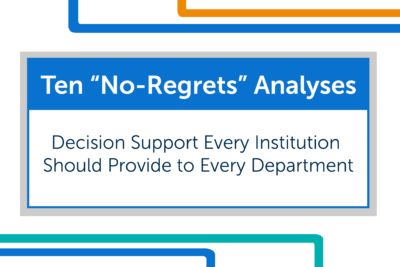Priority Data Analyses to Promote Student Success
10 smart ways to use campus data to support better student outcomes
Student success is a foundational mission of all higher education institutions, and is therefore a prime focus area to build consensus around the need for data governance. These Priority Data Analyses for Student Success should be used to determine strategic focus areas for data governance work at the enterprise level.
By determining enterprise definitions to the associated terms for these analyses, institutions will be able to run effective analytics and stage impactful interventions to generate widespread support for enterprise data governance and business intelligence work.
3 ways to use this resource:
- Focus efforts in data governance to align with desired student success analyses and associated outcomes
- Generate leadership buy-in for institutional investment in business and analytics support on campus
- Develop a shared understanding of the potential value of standardized data and analysis for teaching and learning
Download the full resource or explore the 10 priority analyses below.
Identify high drop-fail-withdrawal courses
Centralized data should help academic leaders focus on high drop-fail-withdrawal (DFW) rate courses to minimize the number of unproductive credits (i.e., attempted but not completed) and to optimize the deployment of scarce teaching and advising resources toward courses that can offer the greatest return in student success for faculty time investment. Identify large courses (e.g., more than 100 students) with relatively low completion rates where minor improvements in course-level progress can have outsized impact in credit completion.
Respond to section capacity red flags
Because few institutions embed student demand data into course planning processes, many schools simultaneously have courses that are underfilled and overfilled, meaning that students lack access to critical courses even while instructors and space could theoretically be reallocated to high-demand courses. Provide deans and chairs with real-time data about how current course enrollment compares to maximum enrollment to let academic managers quickly identify under-enrolled sections and prioritize section addition candidates.
Map term-to-term retention
Overall student retention figures are driven by unit-level progress in registering current students for the following term, but few institutions share unit-level data to help academic managers and staff manage against enrollment goals. Data initiatives should help units understand and manage retention of local students by providing regular updates on unit-level progress to register students in the next semester. If possible, these updates should be weekly during peak registration periods, and delivered to campus in a transparent, clear format that rewards high performers for their successes.
Identify the impact of application timing
Virtually all institutions leverage content of financial aid and institutional applications from students to inform risk models and prioritize outreach to students, but few use the timing of those applications (i.e., the date on which a student submitted materials) as an additional way to identify attrition risks. In many institutional studies, students applying later and especially applying at or after federal deadlines are at much higher risk of attrition than students applying earlier; practitioners suspect that application timing demonstrates important noncognitive factors (e.g., engagement with the institution, grit).
Measure advising process completion
Academic advising can play a critical role in helping a struggling student get back on path to graduation and long-term success, but at many institutions, advising processes are not centrally monitored or managed. As a result, it is difficult if not impossible to know which advisors, and which interventions, are making the most positive difference for students. Data governance groups should support the collection and delivery of advising process completion data (i.e., record when students interact with advisors) to enable more effective management and leverage of advising appointments to help at-risk students.
Isolate late major declaration
While a student may change his or her major multiple times throughout undergraduate education, EAB research has demonstrated that student major switches often follow predictable patterns; some majors tend to remain relatively static (e.g., Nursing), while others may be net “donors” of students (e.g., Computer Science, Biology) or net “acceptors” of students (e.g., Marketing, Business). Available data should help analysts identify students who change their majors late to help prioritize outreach from advisors, and analyze major-major pathways to allow for advising based on the most frequent major clusters.
Encourage full credit load
Across levels of student academic preparation, researchers have found that taking 15 credits per semester rather than 12 improves retention and time to degree. To help encourage more students to enroll with 15 credits per semester, Data governance groups should encourage standardizing definitions for data to perform historical analysis of credit completion ratios, retention, graduation, and time to degree by credits attempted, separating out low and high academic cohorts.
Identify potential credit over-accumulation
Because students frequently change majors, transfer, and suffer setbacks during their academic journey, many will graduate with more credits than are mandated by their degree; these students could have graduated sooner, saving themselves in tuition dollars and the institution in capacity. Not all students that graduate with extra credits are in a bad situation (some may simply wish to explore more academic options) but data governance efforts should help campus partners give all students a clear choice by prioritizing data that makes it possible to reach out to students that have between two-thirds and three-quarters of final requirements complete to ensure that final semesters will align to degree.
Track term-to-term GPA
Cumulative grade point average (GPA) is the most commonly used indicator of academic health, and is usually the main input for earl-alert technologies and advising priorities. However, analysis of current GPA is greatly enhanced by also studying the trend of GPA over time, because students that have declining GPAs drop out at much higher frequency than those with ascending GPAs. Identifying and intervening with declining-GPA students will allow student success teams to reach and support at-risk students in time to course-correct and before challenges become too severe.
Standardize course attendance tracking
Many institution-level analyses have identified that course attendance is highly predictive of critical student success metrics like GPA, retention, and graduation; students that go to class tend to do better, across academic preparation levels. Rather than attempt to achieve complete adoption of attendance-tracking software, intervention should focus efforts on the largest, highest-attrition courses, where the implementation of a single tracking tool could impact hundreds of students. Absences should trigger automatic outreach to missing students; multiple absences should trigger mandatory advising conversations.
You may also like

Data Governance Center of Excellence

10 "no-regrets" analyses
This resource requires EAB partnership access to view.
Access the research report
Learn how you can get access to this resource as well as hands-on support from our experts through IT Strategy Advisory Services.
Learn More